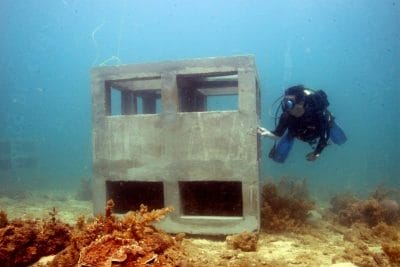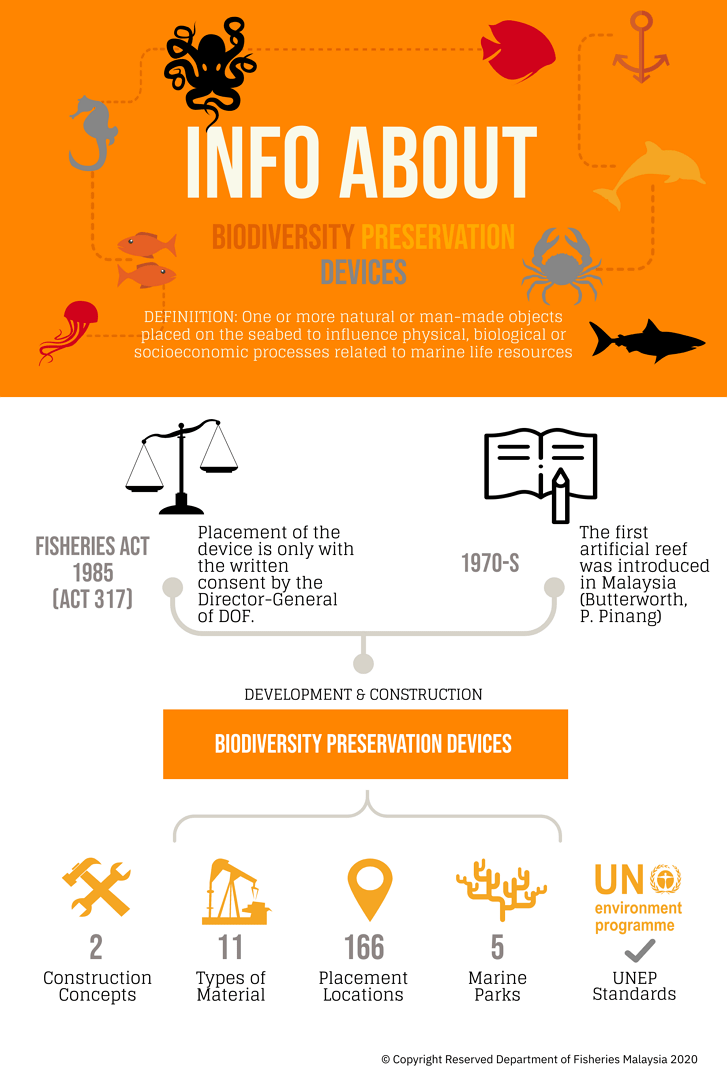
An Artificial Reef is a structure of human construction that is placed on the seabed for the purpose of increasing the density of marine resources.
The main objective of constructing artificial reefs are as follows:
- Increase the productivity of biological and fishery resources in the coastal areas by means of:
- Creating an ecosystem that serves as a sanctuary
- Provide breeding and nursery areas for fish and other marine life
- Restoring and protecting marine habitats damaged by fishing activities and natural disasters
- Creates a barrier for waves/currents to control of coastal erosion.
- Prevents and controls the activities of catching fish using trawlers in coastal areas.
- Establish areas for agro-tourism and recreational fishing activities and SCUBA diving.
- Conduct studies and scientific research.
- Artificial reefs in Malaysia was introduced by the Royal Australian Air Force based in Butterworth in 1970. They build artificial reefs using scrap tires and anchored them at Pulau Songsong for recreational purposes.
- Malaysia is the first country in Southeast Asia to build an artificial reef in 1975. The artificial reef was first built at Pulau Telur, Kedah, on 6 May, 1975 which was developed by using 6,329 tires. Then on October 11, 1975, another site was established near Pulau Payar using 5,229 tyres.
- Research and development of artificial reefs in Malaysia began in 1975 by using scrap tyres. After that, various artificial reef designs were created as a result of the studies conducted by researchers and staff of the Department of Fisheries. Apart from tyres, artificial reefs are also built from PVC, ceramics, boats and concrete anchored in waters less than 5 nautical miles.
- Commencing in 2006, the Department of Fisheries has built artificial concrete reefs, from a mixture of cement, sand and stone while the frame of the reefs were reinforced by using iron.
- Construction of artificial reefs in Malaysia adopted the standards set out in the guidelines by United Nations Environment Programme (UNEP), referred to as “Guidelines for the Placement of Artificial Reefs”.
There are two concepts in constructing artificial reefs:
- Artificial Reef Conservation – aimed at conservation, not catching fish.
- Artificial Reef Recreation – is for recreational fishing in a controlled manner.
Types of Artificial Reef built by the Department are:-
- Tetrapod Reef
- Lobster Reef
- Cube Reef
- Juvenile Cube Reef
- Bioactive Cube Reef
- Recreation Reef
- Juvenile Recreation Reef
- Soft Based Reef
- Trawler Barrier Soft Based Reef
- Juvenile Soft Based Reef
- Iron Reef – new inovation introduced in 2014.
No. of Artificial Reef by Locations
| No. | Type of Material | Kedah | Terengganu | Pahang | Johor | Labuan | Total of Locations |
|---|---|---|---|---|---|---|---|
| 1 | Concrete | 5 | 66 | 7 | 10 | 3 | 91 |
| 2 | Pipe concrete | 1 | 0 | 0 | 0 | 0 | 1 |
| 3 | Tyre | 8 | 3 | 3 | 4 | 0 | 18 |
| 4 | Ceramic pipe | 4 | 0 | 0 | 0 | 0 | 4 |
| 5 | Wooden boat | 1 | 12 | 7 | 4 | 0 | 24 |
| 6 | PVC | 1 | 3 | 0 | 1 | 0 | 5 |
| 7 | Ceramic | 0 | 1 | 1 | 0 | 1 | 3 |
| 8 | Biorock | 0 | 0 | 1 | 0 | 0 | 1 |
| 9 | ATM Machine | 0 | 0 | 1 | 0 | 0 | 1 |
| 10 | Iron Boat | 2 | 7 | 0 | 2 | 1 | 12 |
| 11 | Unjam | 0 | 2 | 0 | 4 | 0 | 6 |
| TOTAL | 22 | 94 | 20 | 25 | 5 | 166 |
- This concept is known as ‘Rigs to Reef’ where disposed used oil rigs are turned into artificial reefs by complying to the guidelines that have been set to ensure that it is safe for marine life.
- In Mexico Bay, USA, more than 100 used oil rigs have been developed since 1980 to become artificial reefs.
- In Brunei, there have been 7 used oil rigs developed into artificial reefs since 1988.
- The first Rigs-to-Reef project in Malaysia started when a Memorandum of Understanding (MoU) was held between PETRONAS and the Department of Marine Fisheries of Sarawak in 2003.
- In 2004, a committee was formed involving the Department of Marine Fisheries of Sarawak, PETRONAS, Sarawak Tourism Board and Shell to implement this project in which the Department of Marine Fisheries, was appointed as the chairman/moderator.
- On 16 November 2004, used oil rigs were anchored into the waters of Baram, and was named as Baram-8 (BA-8). Monitoring conducted by the Department investigators found that the reef had become a habitat for many species of fish and turned into an attractive fisheries recreation area especially for scuba divers.




